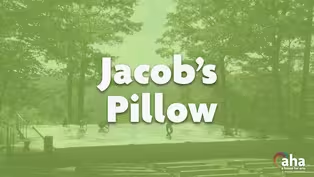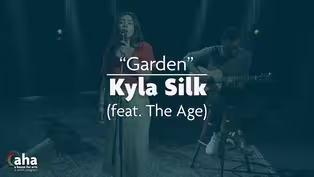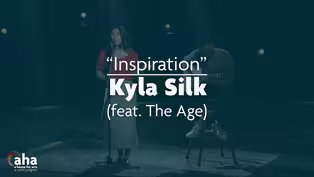
AHA! | 706
Season 7 Episode 6 | 26m 46sVideo has Closed Captions
Jacob's Pillow, a mecca for the contemporary arts world, and a performance by Kyla Silk.
Return to dance at Jacob's Pillow and hear from Executive & Artistic Director, Pamela Tatge, and Director of Preservation, Norton Owen, to learn about this season's offerings, and what we can look forward to next summer. Artist and Foreland's founder, Stef Halmos, has reimagined the space as a mecca for the contemporary arts world. Don't miss stunning performances from Kyla Silk featuring The Age.
Problems playing video? | Closed Captioning Feedback
Problems playing video? | Closed Captioning Feedback
AHA! A House for Arts is a local public television program presented by WMHT
Support provided by M&T Bank, the Leo Cox Beach Philanthropic Foundation, and is also provided by contributors to the WMHT Venture Fund including Chet and Karen Opalka, Robert & Doris...

AHA! | 706
Season 7 Episode 6 | 26m 46sVideo has Closed Captions
Return to dance at Jacob's Pillow and hear from Executive & Artistic Director, Pamela Tatge, and Director of Preservation, Norton Owen, to learn about this season's offerings, and what we can look forward to next summer. Artist and Foreland's founder, Stef Halmos, has reimagined the space as a mecca for the contemporary arts world. Don't miss stunning performances from Kyla Silk featuring The Age.
Problems playing video? | Closed Captioning Feedback
How to Watch AHA! A House for Arts
AHA! A House for Arts is available to stream on pbs.org and the free PBS App, available on iPhone, Apple TV, Android TV, Android smartphones, Amazon Fire TV, Amazon Fire Tablet, Roku, Samsung Smart TV, and Vizio.
Providing Support for PBS.org
Learn Moreabout PBS online sponsorship(Inquisitive music) - [Lara Ayad] Experience the uplifting power of dance at Jacob's Pillow.
Learn all about Foreland, a new arts campus in Catskill.
And catch a performance from Kyla Silk.
It's all ahead on this episode of AHA, A House for Arts.
- [Narrator] Funding for AHA has been provided by your contribution and by contributions to the WMHT venture fund.
Contributors include The Leo Cox Beach Philanthropic Foundation, Chet and Karen Opalka, Robert and Doris Fischer Malisardi, The Alexander & Marjorie Hover Foundation, and The Robison Family Foundation.
- At M & T Bank, we understand that the vitality of our communities is crucial to our continued success.
That's why we take an active role in our community.
M & T Bank is pleased to support WMHT programming that highlights the arts, and we invite you to do the same.
(whimsical music) - Hi.
I'm Lara Ayad, and this is AHA, A House for Arts.
A place for all things creative.
Let's send it right over to Matt Rockowitz for today's field segment.
(jaunty music) - I'm happy to be back here at Jacob's Pillow in Becket, Massachusetts to learn more about what's going on on site and online.
(jaunty music) - Last summer we made the very difficult decision to cancel the Jacob's Pillow Dance Festival for the first time in its 88 year history.
You know this is March of 2020, we didn't know how long the coronavirus would last.
We made a pretty quick decision that we would pivot to a virtual festival, and like so many cultural organizations, it's been a, it was a silver lining of the pandemic.
We reached audiences that we never would have been able to reach before.
80% of our audience was new to Jacob's Pillow.
In other words, they've heard about us but, they've maybe never been here before.
We had a virtual festival and then began to think about whether or not we could have a festival this summer.
(rhythmic music) Well the whole idea was to bring artists and audiences back together safely.
We planned for nine companies to come, one week each, on our major outdoor stage.
It's the Henry J. Leir stage.
And it's been a wonderful way to have people return to dance.
The feeling that people have when they arrive back on campus, or people who've never been here before, the idea that they can experience dance with the backdrop of the Berkshire Hills, there's really, there's really nothing like it.
We really decided that we wanted to maintain our commitment to being accessible.
So, we're offering a broadcast of every single Henry J. Leir stage performance online.
It premiers two weeks after the opening here in person, because we really wanted to create a film.
Give audiences an opportunity to see things through a three camera shoot, that they wouldn't see, even if they're seated in the third row.
So that means gestures, facial expressions, details, and these films have been really an extraordinary way to maintain accessibility here at Jacob's Pillow.
Make sure anyone who wants to experience dance can.
Continue to reach the audiences around the world that we have.
And for the artists, it's going to be an incredible record of this period of time in history.
We have an exhibition called Build Me a Theater.
This is what Ted Shawn said to the architect Joseph Franz of this building right behind us.
He said he wanted a theater for dance, and it ended up being the first theater built for dance in America, built in 1942.
And all these years later, it needs renovations.
So, we have made the decision to renovate the Shawn, add ventilation and air conditioning, which we need to do in a post-COVID world.
And our plan is to open the renovated theater for our 90th anniversary next summer in the summer of 2022.
So the exhibition looks at the history of The Shawn and also the other venues on campus, including the Doris Duke Theater, which tragically burned in November.
(tense melancholy music) We have a plan to rebuild a theater to replace the Doris Duke.
Right now, we're in the process of selecting an architect and we hope to be able to announce when it will open as soon as we understand the scope and the cost and the time it will take to fundraise.
(playful jazz music) - You know, when we thought about what we would show this year in particular, with the Doris Duke Theater having burned this past November, and also with all the plans that we have for the Ted Shawn Theater moving forward.
And, the fact that we were selling tickets for the first time in our outdoor space, the Henry J. Leir stage, we thought really, the place to go would be to look at all of the performing spaces here at the Pillow.
The title "Build Me a Theater", is exactly what Ted Shawn is reputed to have said to Joseph Franz, the architect, when it came time in 1941 to build the first theater.
Joseph Franz, who had already built the Koussevitzky Music Shed at Tanglewood before that time, was the perfect person to enlist to do that.
He really devised a wonderful structure that's all wood.
And that was kind of key, too.
The fact that it was during World War II, when there were a lot of building materials that were restricted.
But wood was not one of them.
So, it was all, all natural, but also taken from the surrounding area.
There're these huge beams that span the theater that were each taken from a single, very old growth tree and engineered by Warren Davis, who was a local black craftsman and entrepreneur, who hand hewed those beams.
And those, there're five of them that span the auditorium.
And they're still really one of the key things about the space that speaks to people today.
I came here as a student, originally, in 1976.
And the history really spoke to me in a way that I had not experienced before.
And that really has become my calling here, is to make all of that history more evident for the everyday visitor, whether or not they know anything about dance.
I don't think that's important.
I think that that part of what makes the Pillow a meaningful place, is that anyone can come here and get an idea about what this place has meant over time.
- It's everything.
It's these gardens.
It's the exhibition space.
It's the ability to bring a picnic and sit outside before the performance.
Our field was so devastated by the pandemic and to be giving artists the opportunity to dance again, for almost all of the companies this summer, we are their very first public performances.
The emotion, the dedication that they put into that performance, and then the audience's excitement to be here.
There's nothing like it.
I'll never forget the feeling of this summer.
- Foreland is an 85,000 square foot arts campus in Catskill New York, that includes galleries, studios, and event spaces.
The campus buildings were originally mills that produced uniforms for union soldiers during the Civil War.
But Foreland's founder Stef Halmos, has now re-imagined the space as a mecca for the contemporary art world.
I sat down with Stef to discover what we can expect to see at Foreland in the weeks ahead.
Stef welcome to A House for Arts.
It's such a pleasure having you.
- Thank you for having me.
- So, tell us a little bit about Foreland.
I know you bought this large building complex in 2017 and it's been in development since then.
But what is Foreland?
Just for our viewers.
- Sure.
Foreland is a contemporary arts ecosystem.
With about 30 some odd artists' studios.
We have multiple exhibition spaces.
We have a special events space.
We have food and beverage.
And it's a campus that's spread over three historic structures that were built in the 1800's and have since been rehabilitated and renovated.
- Right.
'Cause they used to be mills.
Right?
- Exactly right For soldier uniforms, is that right?
- Yeah.
They were built during the Civil War and they served to produce the union soldiers uniforms.
So- - [Lara] Amazing - The Yankees.
- [Lara] Yeah.
- Yeah.
- [Lara] Yeah.
That's amazing.
- It's really cool.
- I've seen pictures of this space and it's beautiful, first of all, and it has this very kind of simple, natural beauty that I think evokes upstate New York very much.
Is that why you chose these mills as the birthplace for Foreland?
- No, I've always loved old buildings.
I, and I love architecture.
I love design.
And there's a long history of artists inhabiting and then by their nature, rehabilitating old or abandoned structures and kind of creating colonies in these spaces.
And when I saw this particular, our flagship building, the big building, I just fell in love.
- [Lara] Yeah.
- And yeah it is.
It is.
It's like a big beautiful Catskill mountain.
- Yeah.
Yeah.
You know it's interesting, you're talking about having this sort of love for rehabilitating something that is beautiful, in essence.
I know that you're an artist yourself, is that correct?
- [Stef] Yeah.
- You make your own sculptures and you have a studio at Foreland- - I do.
- [Lara] Itself.
- I've seen pictures of your artworks and they're really awesome.
I mean, they're really play with texture and form a lot.
Tell us a little bit about how you started making these sculptures.
- I mean, I worked in photographs for the longest time.
And then I had my studio lost in Hurricane Sandy.
And I really think that was the impetus for looking for something permanent.
I think it sent me on a quest for permanence and for something bigger than just going into my studio and making these kind of fragile images and objects.
So I started to build these big, kind of, clunky sculptures.
And, for some reason I just really fell in love with the figuring out how to orientate myself in space.
And that's how I ended up coming to do a giant development, I think.
- Yeah.
Yeah.
That's fantastic.
I mean, as a practicing artist and as someone who's, I know you've gone to Miami University and California College of the Arts for your education in the arts.
You know, now that you're kind of stepping forward, not only as a practicing artist, but also to create a space where you're supporting whole communities of artists, what's one thing, or maybe even two things, that you wished you had learned when you were going to college and learning about art.
- Yeah I mean, honestly, I think a of the things that I learned, especially in my Master's degree, I had to unlearn after my Master's degree, oddly.
- Like what for instance?
- Well, I don't like art speak.
So, I had to get out of art school and remember how to start talking about my work, just from my gut.
- [Lara] Right.
- Just like, two people having conversations, not one person and one robot having a conversation.
- [Lara] Right I mean, an art speak is something you can, it's kind of like something you learn in art school, but it's also sometimes you, something that you see on the wall printout of an exhibition - [Stef] Exactly.
Right?
- Exactly - [Lara] And these, these fancy theoretical terms, - [Stef] Exactly.
that's art speak.
- Exactly right.
And I think that strips a lot of the intimacy away of what it is to be a working artist.
And I am someone that really believes in gut as guide.
That's how I root my practice I would say, as a working artist.
So, but to get back to your question, I really think the biggest thing that I would teach if I was, wanted to be an educator, or what I would encourage more Master's programs and Undergrad programs to do, is to talk about entrepreneurship with artists.
Because that's what you are.
You're your own, you do your own marketing, your own accounting.
I mean, you have to understand the art market or you can't kind of compete.
So a lot of us come out of art school being great artists, but terrible business people.
And you need to be both, which doesn't sound very fun or sexy, but it's true.
- Yeah.
Yeah, you know, it's interesting you say that stuff because I think the common perception, even I think sometimes among artists themselves, unfortunately, is that, well artists and business people are two different categories or breeds of humans.
(both laugh) - Sure.
Yeah, totally.
- The two don't merge.
But, what you're revealing is that actually, you're going to art school to make art and then sell your product.
I mean you're selling what you make and art has always been sold.
Right?
- Always - Absolutely.
- That seems like a really important thing there.
That they are not actually, the artist is actually a business person at heart.
They're just not given the tools.
It sounds like - [Stef] Yeah.
- A great artist and a great business person, one doesn't preclude the other.
And, in fact, I think it's that I spent decades as a working artist, that really helped me stand my ground and figure out how to become a developer.
I mean I'm not, it's just me on these big giant construction sites, just surrounded by men and hardhats calling shots.
- [Lara] Yeah.
And the way that I did that is by being a good artist I think, honestly.
That was the root of it all because I knew what I need.
I mean, what needed to be built.
I knew I could look at floors and say, we have to save these floors.
No, we shouldn't cover these floors.
Let the artists have these floors.
These hundreds of year old planks.
I just knew that artists would love it.
So it was my guts as an artist that helped me be a good developer but, the developer is going to teach me how to live in the art world better.
- [Lara] Yeah.
- Yeah.
- That's fantastic.
And I know there, there have been other people from outside these artist communities and even just going within it that have taken interest in Foreland.
I know New York representative Antonio Delgado visited the site earlier this April.
And that some politicians are now finally seeing the arts as you know, these art institutions, rehabilitating spaces into art spaces, as vehicles for promoting the economy in upstate towns and cities.
How do you see Foreland playing a role in Catskill's economy in the near future?
- That's a great question.
And it's a really important one to me.
I think Foreland is part of a rising tide and rising tides lift all boats.
So Foreland now, you take 85,000 square feet that was not being used.
It was just darkened windows.
And you fill that up with people.
Main Street is going to continue to come alive.
The businesses that were on Main Street before Foreland, after Foreland, they're going to be full of new patrons.
So that's huge, but more regionally, also.
We have swells of artists that are leaving city centers, looking for more utopic ways of working or places where they can raise young families, own a home and be a working artist and have access to good economic drivers that are larger cities, let's say, and they need studios.
So Foreland is the only place like it within a hundred miles.
And I think it'll really regionally be a very cool destination.
Not just for tourism, but for the artist, for the arts.
- What kinds of programs do you have coming up that people can look forward to in August or September, further down the line?
- We have Rachel Uffner Gallery and Mrs. Gallery.
They're doing a joint exhibition in our Water Street galleries, which is this big, beautiful 400 or sorry, 4,000 square foot space.
- [Lara] It's hard to wrap your head around a space quite that large, right?
- I just, I always forget.
I put myself in the building when I talk about the building to remember where I am.
And that's opening August 14th.
That'll be open Saturdays and Sundays through mid September.
And then we're doing a big public launch, which will be, we're hosting a giant exhibition by New Art Dealers Alliance, NADA for short.
And there will be over 84 galleries and over a hundred artists exhibiting their work all throughout the campus.
- [Lara] Wow.
- So you come in one place and you end up exploring every single inch of the building and seeing work.
And that is happening August 28th and 29th from 11:00 AM to 8:00 PM.
- That is- - [Stef] Free and open to the public.
- Free and open to the public.
- I know awesome is kind of a lame word, but it is truly awesome, you know?
- Awesome in the fullest sense of the word.
- [Stef] In the fullest sense of the word.
And then you get the added benefit of getting to see work installed in these spaces and see how the work activates the space and the space activates the work.
And I think it'll be really something special.
- Amazing.
That sounds inspirational Stef.
- Yeah, I hope you'll come.
- Yes.
Yes, absolutely.
I think everybody's going to be looking forward to checking out what Foreland has in store for us.
So thank you so much for being on A House for Arts.
It was such a pleasure having you.
- It was a pleasure having you, too.
Or wait, it was a pleasure talking to you.
Can we take that one back?
(both chuckling) - Please welcome Kyla silk.
(gentle guitar music) - Hi everybody.
My name is Kyla silk.
I'm accompanied by the wonderful Age today.
We've got some great music to show you all.
This first song is called "Inspiration".
And this song is just about trying to find your creative spark.
And sometimes you might doubt if that's going to be coming.
But... ♪ I know you'll come ♪ ♪ I know, I know, I know you'll come ♪ ♪ I know, I know, I know ♪ ♪ Oh, you'll come ♪ ♪ I know, I know, I know you'll come ♪ ♪ Inspiration ♪ ♪ How the hell do I find you ♪ ♪ Where do you come from ♪ ♪ You fit together like the pieces of a puzzle ♪ ♪ But I can't find you yet ♪ ♪ No, no, no, no ♪ ♪ Inspiration ♪ ♪ Why you leave me all alone with a broken mirror ♪ ♪ Bits and pieces of me showing, but never clearer ♪ ♪ And I can't find me yet ♪ ♪ No, no, no, no ♪ ♪ But I know you'll come ♪ ♪ I know, I know, I know ♪ ♪ Oh, you'll come ♪ ♪ I know, I know, I know ♪ ♪ Oh, oh, you'll come ♪ ♪ I know, I know, I know you'll come, hey ♪ ♪ Oh Inspiration ♪ ♪ You'd be nothing without a little motivation ♪ ♪ So come and see, yes I can show you our location ♪ ♪ No, you know I'm not that far ♪ ♪ Oh, no, no, no, no ♪ ♪ Inspiration ♪ ♪ Well, do you need me ♪ ♪ to come and point you in the right direction ♪ ♪ 'Cause I can hold you down ♪ ♪ With some protection ♪ ♪ No, you know I'm not that far ♪ ♪ No, no, no, no, no, no ♪ ♪ I know you'll come ♪ ♪ I know, I know, I know ♪ ♪ You'll come ♪ ♪ I know you'll come ♪ ♪ I know, I know, I know ♪ ♪ Oh, ooh ♪ ♪ Ooh ♪ ♪ I try and try to succeed ♪ ♪ Though I find inspiration in this life ♪ ♪ Say it's fine ♪ ♪ The inspiration in my mind ♪ (rhythmic guitar music) Okay.
So this song is called "Garden".
It's on my debut EP.
It's the title of my debut EP.
And this song is just talking about not letting anybody interfere in your self growth, and just helping each other, if anything, and in any way, to be the best versions of ourselves.
To grow into our gardens and be beautiful flowers.
But this song goes out to anybody that feels that they need to know what they need to know.
So this is the chorus.
♪ Don't tell me how to grow in my own garden ♪ ♪ Don't try to block the sun, shine the light in ♪ ♪ I'm a wildflower blooming again ♪ ♪ Move on, take a different path ♪ ♪ I'm about to go far and you won't hold me back ♪ ♪ You can make a wish but ♪ ♪ This dandelion's standing tall today ♪ ♪ And you'll be damned if you blow her away ♪ ♪ Ooh, overflowing my pot with green energy ♪ ♪ Or are you trying to poison me, yeah ♪ ♪ Oh, cleanse my soil from all your toxicity ♪ ♪ 'Cause baby it's time for me ♪ ♪ Don't tell me how to grow in my own garden ♪ ♪ Don't try to block the sun, shine the light in ♪ ♪ I'm a wildflower blooming again ♪ ♪ Why do you care what people say ♪ ♪ They can't control you ♪ ♪ Won't break your stride today ♪ ♪ Not trying to scold you ♪ ♪ Just know your growth is as important too ♪ ♪ And you know I believe in you ♪ ♪ Ooh, plant the seed inside your mind that you can be ♪ ♪ Anything that you dream to be, yeah ♪ ♪ Oh, don't block your blessings, manifest your destiny ♪ ♪ And act accordingly ♪ ♪ No, don't tell me how to grow in my own garden ♪ ♪ No, no, no, no, no ♪ ♪ Don't try to block the sun, shine the light in ♪ ♪ No, don't tell me how to grow in my own garden ♪ ♪ No, don't try to block the sunshine ♪ ♪ Shine the light in, yeah ♪ ♪ Doo ♪ ♪ No, no ♪ ♪ No, no, no, no ♪ ♪ Yeah, I'm a wildflower blooming again, yeah ♪ - Thanks for joining us.
For more arts, visit wmht.org/aha and be sure to connect with WMHT on social.
I'm Lara Ayad, thanks for watching.
(gentle music) - [Narrator] Funding for AHA has been provided by your contribution and by contributions to the WMHT venture fund.
Contributors include The Leo Cox Beach Philanthropic Foundation, Chet and Karen Opalka, Robert and Doris Fischer Malisardi, The Alexander & Marjorie Hover Foundation and The Robison Family Foundation.
- At M & T Bank we understand that the vitality of our communities is crucial to our continued success.
That's why we take an active role in our community.
M & T bank is pleased to support WMHT programming that highlights the arts, and we invite you to do the same.
AHA! 706 | Dance with Jacob's Pillow
Video has Closed Captions
Clip: S7 Ep6 | 6m 51s | Learn about what's coming up at Jacob's Pillow. (6m 51s)
AHA! 706 | Kyla Silk feat. The Age "Garden"
Video has Closed Captions
Clip: S7 Ep6 | 3m 55s | Don't miss this stunning performance of "Garden" from Kyla Silk featuring The Age. (3m 55s)
AHA! 706 | Kyla Silk feat. The Age "Inspiration"
Video has Closed Captions
Clip: S7 Ep6 | 3m 28s | Don't miss this stunning performance of "Inspiration" from Kyla Silk featuring The Age. (3m 28s)
Video has Closed Captions
Preview: S7 Ep6 | 30s | Jacob's Pillow, a mecca for the contemporary arts world, and a performance by Kyla Silk. (30s)
AHA! 706 | Stef Halmos of Foreland
Video has Closed Captions
Clip: S7 Ep6 | 9m 16s | Founder, Stef Halmos, has reimagined Foreland as a mecca for the contemporary arts world. (9m 16s)
Providing Support for PBS.org
Learn Moreabout PBS online sponsorshipSupport for PBS provided by:
AHA! A House for Arts is a local public television program presented by WMHT
Support provided by M&T Bank, the Leo Cox Beach Philanthropic Foundation, and is also provided by contributors to the WMHT Venture Fund including Chet and Karen Opalka, Robert & Doris...
















